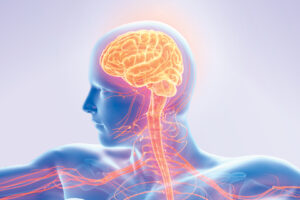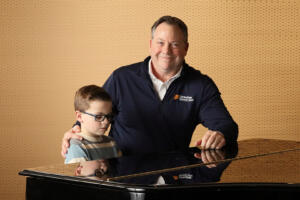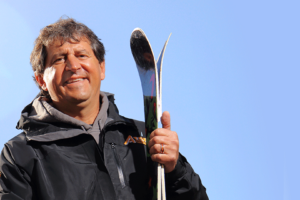Anyone who lives with or cares for someone with Parkinson’s disease or essential tremor knows there are good days and not-so-good days. But what if you could directly stimulate or calm the area of the brain causing the tremor?
Essential tremor is a neurological disorder that causes involuntary and rhythmic shaking. While it can affect nearly any part of the body, it occurs most often in the hands. Parkinson’s disease, another movement disorder, causes tremors in the hands, legs, and other areas.
Deep brain stimulation (DBS) is a treatment that helps “reprogram” the portion of the brain that controls movement. With DBS, most patients experience tremors less frequently and can often decrease tremor medications. “For people with these types of neurological disorders, the brain’s electric signals fire in a dysregulated pattern,” explains neurologist Jia Zhen Cheng, MD. “Through a small device implanted into the structure of the brain, we’re able to provide stimulation input to the brain cells and surrounding neural tissues to possibly reset the network.”
A Deeper Dive into DBS
DBS was approved by the U.S. Food and Drug Administration to treat essential tremor in the late 1990s and Parkinson’s disease in the early 2000s.
Candidates for the therapy undergo an interdisciplinary evaluation, including assessments from a neurologist, neurosurgeon, psychologist or neuropsychologist, and physical therapist. Then, a series of MRI images are taken so the neurosurgeon can visualize the patient’s brain and determine the best route to reach the area that controls movement.
The procedure is available to CentraState patients through the hospital’s partnership with Atlantic Health System. During the procedure, electrodes are carefully placed within the brain through the pre-designated route. To control and adjust the electrical current, a pulse generator – a device similar to a pacemaker – is implanted under the skin of the patient’s chest. Patients typically stay in the hospital overnight and may return to their regular activities several days later.
About two to three weeks after surgery, Dr. Cheng begins programming the device. Patients are asked to perform certain activities and exercises while she calibrates the signal using a programmer. It may take a few sessions to ensure that the current is properly programmed to optimally alleviate symptoms. During this process, Dr. Cheng also evaluates and adjusts the patient’s medications if needed.
“After DBS, 80 to 90 percent of patients see improved clinical symptoms, reduce their use of related medications, and enjoy a better quality of life,” says Dr. Cheng.
To learn more about the Movement Disorder Program at CentraState, visit centrastate.com/movement or call 866-CENTRA7 (866-236-8727).





